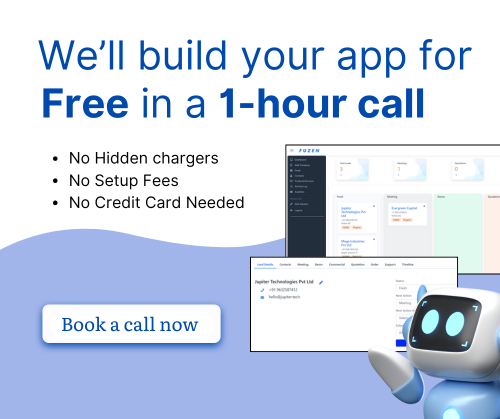Building Project Management App With Fuzen
Project management tools are essential for keeping tasks and projects organized. In fact, the global market for project management software is estimated to reach a drastic $4.7 billion according to Quixy.
But every industry has unique needs. In this post, we will learn to build a basic project management app without writing a single line of code skills on Fuzen. This app can be further customized for any industry - whether it's construction, healthcare, marketing, or beyond.
By the end of this post, you'll have a working app that lets you create and manage projects, track tasks, visualize timelines, and keep up with your to-do lists.
Ready to build something amazing? Let's get started!
Setting up the data structure
Before we build the user interface, we need to set up the data structure that will support our project management app. This is where we define how information about projects and tasks will be organized and stored. So, let's start by outlining the data structure for our project management app.
Projects collection
Within the Projects collection, each entry represents a distinct project. Here are the essential details we'll capture for each project.
- Project Number: A unique identifier for each project.
- Name: The name of the project.
- Priority: The priority level of the project.
- Project Value: The financial value or budget of the project.
- Description: A brief description of the project.
Tasks collection
The Tasks collection is where we store individual tasks associated with each project. Here's where we manage all the tasks associated with each project.
- Title: The title of the task.
- Task Type: The type or category of the task.
- Priority: The priority level of the task.
- Planned Start Date: The planned start date of the task.
- Planned End Date: The planned end date of the task.
- Progress %: The current progress of the task in percentage.
- Task Owner: The person responsible for the task.
By structuring our data in this way, we ensure that our project management app can effectively manage multiple projects and their associated tasks. This clear organization helps users stay on top of their work and maintain clarity on project timelines and progress.
Creating user-friendly pages
With our data structure in place, let's move on to crafting the app pages. This is where you get to interact with your app. We'll break it down step by step to make it easy for you.
1. Project dashboard
Let's start by building the Project Dashboard. Think of it as your app's main hub. Here's what you'll find and how to set it up

Project creation form
First, we'lladd a form that allows you to easily create new projects. This form will be connected to the Projects collection, ensuring that all new projects are added seamlessly to your database.
- Fields to Include: Project number, name, priority, project value, and description.
- How to Add: In your Fuzen dashboard, select the form tool, link it to the Projects collection, and include the necessary fields.
Project list table
Next, let's add a table to display all ongoing projects. This table will show key details of each project, making it easy to see what's happening at a glance.
- Fields to Display: Project name, priority, and status.
- Details Button: Add a button in each row that lets you view more details about the selected project.
- How to Add: In Fuzen, use the table tool, link it to the Projects collection, and choose the fields you want to display.
2. Project details page
Next, we need a Project Details Page to highlight the specifics of each project. Here's what it will offer and how to build it

Project overview
This section will provide a snapshot of the project's key information.
- Fields to Include: Project number, name, priority, project value, and description.
- How to Add: On the Project Details Page, use text and label elements to display the project information.
Task management
We'll also add an editable table to manage tasks associated with the project. This table will be connected to the Tasks collection and filtered by the project's ID.
- Fields to Include: Task title, type, priority, start and end dates, progress percentage, and task owner.
- How to Add: Use Fuzen's editable table tool, link it to the Tasks collection, and set up the filter to show only tasks related to the current project.
Visualizing project timelines
To keep track of project schedules and progress, let's add some visual aids.
Project calendar
This calendar view will display tasks laid out over time, helping you manage deadlines effectively.
- How to Add: In Fuzen, use the calendar tool, link it to the project task data, and set it to show tasks based on their start and end dates.
Gantt chart
The Gantt chart will help you visualize task timelines and progress, ensuring everything stays on track from start to finish.
- How to Add: Use Fuzen's Gantt chart tool, connect it to the Tasks collection, and configure it to display the planned duration and progress of each task.
3. Task details page
For detailed task management and updates, we'll need a Task Details Page. Here's what you'll add.

Progress update form
This form will allow you to update task details and track progress. It ensures that you always stay up-to-date without cluttering your workspace.
- Fields to Include: Task title, type, priority, start and end dates, progress percentage, and task owner.
- How to Add: On the Task Details Page, use the form tool, connect it to the Tasks collection, and ensure it’s set for updating existing tasks.
4. Personalized to-do lists
This page will focus on what's next with a list of tasks assigned to you and those still pending completion. It filters tasks based on the current user and task status, showing only the tasks that need your attention. This personalized view helps you stay productive by highlighting your immediate priorities.

Here’s how to set it up.
- How to add: Use the to-do list tool in Fuzen, connect it to the Tasks collection, and set the filter to show tasks assigned to the current user and tasks that are still pending.
Customizing the app
The best part? You can tailor this app to fit any industry or specific use case. Here are some ideas on how to customize it.
Custom workflows
You can add workflowsthat reflect the unique processes of your industry. For instance, in construction, you might include workflows for site inspections, material procurement, and milestone approvals.
- How to Add: Use Fuzen's workflow tools to design and implement custom workflows that match your industry needs.
Specialized forms and charts
You can also customize forms to collect industry-specific data and create charts that visualize metrics relevant to your field. For example, in healthcare, you might add forms for patient information and charts that track treatment progress.
- How to Add: Use the form and chart tools in Fuzen, and tailor them to collect and display the specific data your industry requires.
By following these steps, you'll build a robust and versatile project management app with Fuzen that can be adapted to any industry's needs.

Conclusion
Congratulations! You've now built a comprehensive project management app with Fuzen that empowers you to:
- Create and manage projects effortlessly.
- Assign and monitor tasks seamlessly.
- Visualize project timelines with ease using calendar and Gantt chart views.
- Stay on top of your tasks with personalized to-do lists.
Need some help to build the app. Feel free to contact the Fuzen team.

